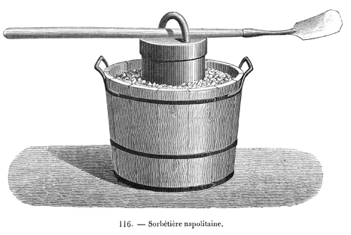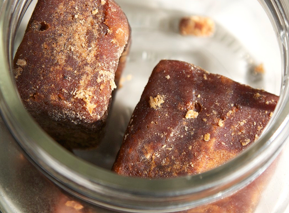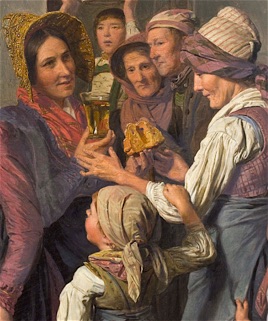ice cream, crème glacé France, gelato Italy, Eis Germany, Gefrorenes Austria (dated)
Ice cream is made more or less two ways, either with mixture of cream and eggs or just cream itself. Most likely, the dessert as we know it was first developed in Italy in the 1600s when Italian confectioners discovered that if you placed a sweetened liquid in a tub of ice and salt and kept mixing it, you’d get a delicious spoonable dessert (see illustration). By the end of the century the secret was out as ice cream makers across Europe took the concept and ran with it. Today, there’s hardly a country that doesn’t have some version of ice cream. See also
kulfi (below).
jaggery India, rapadura Brazil, panela Colombia, piloncillo Mexico
Raw sugar made by boiling down sugar cane until it forms a solid or semisolid dark brown mass. A similar product is made by boiling down the liquid from certain types of palm.
jalebi (also jilebi) South Asia
To make these violently colored strands of dough confectioners drizzle a thin batter through a hole in a coconut (or more commonly a purpose-built vessel) into hot fat. Once crispy these are then dipped into a sugar syrup.
Jalebi batter can be made with bean flour (urad dal), chickpea flour or even wheat flour. The dessert seems to originate in Persia where a similar dessert called
zalibīya is popular.
A fruit-flavored, gelatin-based dessert mix first devised and named
Jell-O by May Davis Wait in 1897.
”Flower petal rice cakes” sold at the New Year and highly desired by practitioners of the Japanese tea ceremony.
kasutera also castella Japan
A spongecake made with whole eggs, flour, sugar and honey. The technique for making the cake was almost certainly introduced into Japan by the Portuguese in the later part of the 16th century (a recipe appears in the early 17th-century
Southern Barbarians’ Cookbook).
see p. 96 The name stems also stems from the Portuguese
paõ de Castella, or “bread of Castille.”
The Japanese take on fios de ovos. Like
kasutera, a recipe first appears in the early 17th-century
Southern Barbarians’ Cookbook.
key lime pie United States
A custard pie made with the small, flavorful limes common to southern Florida and most of Latin America. The crust is typically made with crushed graham crackers and the filling often includes condensed milk. The pie most likely originated in the early part of the 20th century in the Florida Keys.
Bumpy sugar ball candy. From the Portuguese
confeito.
A pastry (“butter cake” in the local Celtic language) traditional to Brittany made by folding butter and sugar between sheets of puff pastry, then baking it until it caramelizes into a super-crisp, buttery disk.
Kugelhupf (also Gugelhupf) Germany/Austria, kouglof (also kougelhopf and suglhupf) France, babka Poland, bábovka Czech Republic, bundt cake United States
A sweet yeast bread or cake popular across Central Europe and parts of the United States. The earliest recipes are German. (See, for example
Freywillig aufgesprungener Granat-Apffel des christlichen Samariters [1731] 524.) The name (literally “ball head” in German) may be derived from the shape of the molds
which resembled a medieval woman’s hairdo. Today, decorative ring-molds are more common; bundt cake means, circle cake. Early versions were either made with yeast or leavened by extended beating of eggs. With the introduction of chemical leavening in the nineteenth century, it became more common to use baking powder in the batter, though yeast-leavened versions still exist, most notably in Alsace.
South Asia’s answer to ice cream,
kulfi is made by filling a conical mold (from which it gets its name) with flavored, sweetened evaporated milk. (It is not churned during freezing, unlike ice cream.) According to K.T. Achaya’s
Dictionary of Indian Food (132) the dessert was either brought by the Mughals from Central Asia or possibly developed by them in Delhi. Again according to Achaya, a description of the dessert appears in the
Ain-i-Akbari (1590 CE). If that is the case, the English translations do not include it. For an updated recipe see
Deeba Rajpal’s blog.
A clear, noodle-like jelly make from the root of the kudzu plant (
Pueraria lobata).





















